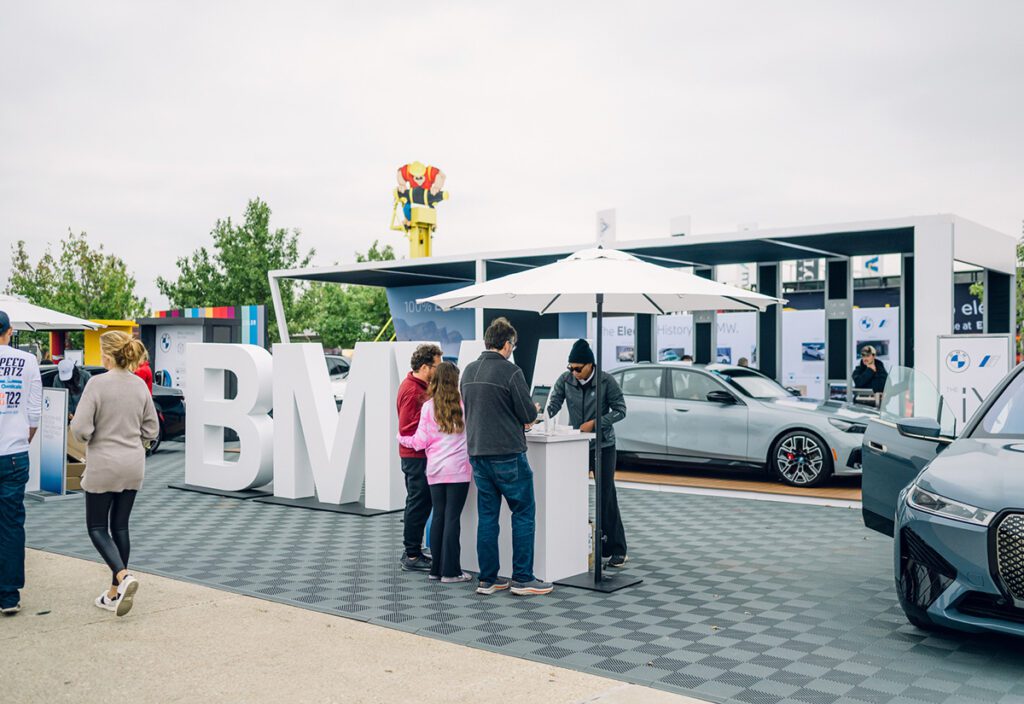Major automotive manufacturers and consumers are embracing an electric future, with U.S. consumer EV sales expected to have hit a record high by the end of 2023—a 35-percent increase from 2022, according to the International Energy Agency. With the release of the Ford F-150 Lightning and its towing capacity and Rivian’s announcement of a commercial van for U.S. fleet customers coming in 2024 (much like its Amazon Electric Delivery Van), mobile tour marketers are on course for a piece of the progress, too.
It’s a space with many challenges to still overcome and many moving parts that will impact budgets and logistics. But experts following it closely say there’s no time like the present to get ahead of the curve. Here, we explore some of the key factors to consider around the future of EVs for engagements on the go.
 More From the EV Sector:
More From the EV Sector:
- Q&A: How Cadillac is Launching its LYRIQ EV with a 360-degree Traveling Theater
- Chevy’s Enduring CMA Fest Program Returns with Rides, Vibes and TikTok Moments
Costs are still high, as is demand.
 The lack of available EV fleets of trucks or vans for renting or leasing is a challenge at the moment, as is the flexibility of these kinds of agreements for an experiential marketing program. It’s either you fully own the asset, or get caught in a multiyear lease for an EV that your brand or client may need for only one season.
The lack of available EV fleets of trucks or vans for renting or leasing is a challenge at the moment, as is the flexibility of these kinds of agreements for an experiential marketing program. It’s either you fully own the asset, or get caught in a multiyear lease for an EV that your brand or client may need for only one season.
“At first, the problem was availability. Most of the electric vehicle manufacturers just didn’t have inventory. That’s becoming less and less of an issue. But with that [demand] comes price,” says Issa Sawabini, partner at Fuse, which specializes in touring programs. “We need to budget for these vehicles, but when there are markups, it becomes problematic to justify the cost.”
Much like the consumer tax credit available for EV purchases, there are tax incentives available for businesses purchasing an EV. There aren’t, however, enough meaningful incentives that apply to installing a charging infrastructure in locations like your company headquarters. That effort also comes at a price.
Joy Gardner, executive director for Empire Clean Cities in the New York Metro region—one of 75 regional coalitions funded by the Department of Energy across the country with a mission to reduce emissions and cut petroleum consumption within the transportation sector—says this infrastructure can cost up to six figures. However, many states, like California, are adopting or have adopted a Low Carbon Fuel Standard that makes heavy polluters pay to help offset costs for fleets that are electrifying.
“It’s hard to convince folks that when you calculate the reduction in fuel costs and maintenance costs, that the upfront cost pays for itself in time. And then if you incorporate investments in vehicle-to-grid technology, that it does make good business sense,” Gardner says. “But the initial price tags on the vehicles is still pretty substantial, and that’s a challenge.”
When a client requested an electric bus for a mobile tour, the team at brand activation agency Inspira informed them that for a localized program they could procure one, but for a multimarket tour, the bus would need to be towed due to the current charging station availability nationwide. Instead, the team leveraged a propane-fueled bus—a step up from diesel as far as environmental impact.
Unlike EV trucks or vans, fleets of EV sedans are readily available for short-term use—for instance, Hertz offers fleets of Teslas and Polestars for rent. “They’re good for a localized marketing blitz, but not necessarily for a tour,” says Ralph Failla, senior account director at Inspira. “It’s nice to know they are there and that the price is comparable to renting a Jeep or Volkswagen.”
Charging infrastructure is complicated.
 There’s a network of nearly 60,000 charging stations across the U.S. (you can check out an interactive map on the Department of Energy’s Alternative Fuels Data Center website). But experts say you don’t always know the charging speed of these stations or, more importantly, the configuration surrounding the charging station—key details for your schedule and for things like figuring out if the trailer you’re hauling will fit in the space while you charge. As consumer demand for larger EVs capable of hauling RVs or boats increases, so will the demand for infrastructure that supports them.
There’s a network of nearly 60,000 charging stations across the U.S. (you can check out an interactive map on the Department of Energy’s Alternative Fuels Data Center website). But experts say you don’t always know the charging speed of these stations or, more importantly, the configuration surrounding the charging station—key details for your schedule and for things like figuring out if the trailer you’re hauling will fit in the space while you charge. As consumer demand for larger EVs capable of hauling RVs or boats increases, so will the demand for infrastructure that supports them.
“When you’re a professional on the road, you need to be in and out fast, you need the ultra-high-speed charging; we don’t have time for two-, three- or four-hour stops. And a lot of those types of charging stations are more limited in their locations,” Sawabini says. “If you come through and have to disconnect the trailer to charge up and then reconnect the trailer, it’s a big challenge, and it makes it unpractical.”
In addition, experts say the “repair infrastructure” on these charging stations isn’t there yet either, and so if a high-speed station goes down, it could bust the schedule and the budget, because time is money.
Gardner points to another challenge for EV fleet managers who offer a pool of commercial electric vehicles for rent, delivery or corporate use in densely urban areas like New York City. Their depots are typically located around older buildings and locations not set up for a fueling infrastructure. And so, they fuel or they charge offsite; or they have a single charging station and the vehicles are parked in such a tight way that it takes time to maneuver them around to take advantage of it.
Schedule setting will be different.
Overall, experts across industries say the cost savings on fuel will be legitimate with the adoption of EVs, but there are unknowns for mobile tour managers and fleet owners putting together a budget and strategy.
“Depending on where you’re at in the country and who your utility provider is, many utilities are still working out what their demand pricing structure is, as well,” Gardner says of charging stations at the per kWh price. “And so, if that’s not worked out and a fleet isn’t aware of what the best time to charge is, or if they don’t have a good charge management system in place, then they could have a bit of sticker shock on their first electricity bill.”
For mobile marketing suppliers like CGS Premier, which specializes in custom experiential trailers, the current weight of the available EVs don’t quite have the capacity for certain displays. Greg Peterson, ceo and president, says while the team has leveraged solar energy for displays and battery banks like Tesla’s Powerwalls, both still need to be plugged in overnight to charge or need power from a generator to run otherwise.
Much like mobile tour managers set up gas accounts for their traditionally fueled mobile tour vehicles, in the future, tour managers may need to set up multiple charging accounts with different providers, like Electrify America. Sawabini says creating flexibility for the staff on the road will be critical to ensuring they can get to that next charge efficiently. “Normally it takes five minutes to gas up and go, right? It’s just different,” he says.
A cleaner experience overall.
 Failla says one of the unexpected benefits of some of the mass-market, heavy-duty EVs is the auxiliary power capacity. He recalls how a friend of his who plays in a band recently purchased the Ford F-150 Lightning (which can run nearly 400 miles on a full charge). The individual hosted a gig in his backyard and ran multiple amplifiers from the truck battery.
Failla says one of the unexpected benefits of some of the mass-market, heavy-duty EVs is the auxiliary power capacity. He recalls how a friend of his who plays in a band recently purchased the Ford F-150 Lightning (which can run nearly 400 miles on a full charge). The individual hosted a gig in his backyard and ran multiple amplifiers from the truck battery.
“Again, commercialization is coming, but it made me think that we may not need to bring around generators anymore, which is more emissions,” he says. “The power on those batteries can run eight hours of continuous, pretty strong amplification and sound, and so the basic stuff, from a charging station for devices to a kiosk—everything at your footprint could be fueled off of that. And for quick events in a retail parking lot, you wouldn’t need to find an outlet or bring a small generator with you.”
Of course, one of the obvious benefits of EVs is that they’re better for people—your staff and your consumers. They can provide warmth in cold-weather environments without burning gas and creating fumes (many have safety codes that allow them to be placed in a “non-drive” mode while they’re idling). Folks waiting outside a vehicle for a sampling experience or demo won’t have to breathe in fumes either.
And, perhaps, a less talked about benefit: It’s a quieter, more comfortable ride for tour teams on the road with more room for storage of personal items—less “wear and tear” on your people, in addition to the environment.
iStock Photo credit: Lyudinka; Dmitry Kovalchuk; SiberianArt; MrJub
HOT PROPERTY: INSIDE THE ELECTRIFY EXPO
Founded in 2019, the Electrify Expo was designed to create a landing spot for deep engagement with brands across the EV space at a time when most EV gatherings were led by volunteers and focused on micro-mobility only. But the folks behind the expo have noticed a dramatic shift in who comes to the event and why.
In the early years, the events attracted an eco-conscious crowd, as well as early tech adopters. This year, mainstream consumers flocked to the expos, which took place in seven cities (kicking off in May in Long Beach, CA, and wrapping in November in Austin, TX). They asked fewer technical questions and, instead, seemed more focused on the value propositions of the brands.

The multicity Electrify Expo is attracting big EV brands and a large, diverse audience of consumers.
“There are more EVs in the market, there are more consumers who are understanding that this is happening, this transition is happening now, and I think that explains a lot of the growth that we have from the sustainability mindset to this new wave of overall curiosity—and Electrify Expo being the place where people are getting their questions answered,” says BJ Birtwell, founder and ceo of Electrify Expo, a veteran of the automotive event space.
At Electrify Expo, brands are able to move volume and allow consumers to make purchases on-site. Major automotive brands including BMW, Ford, Kia, Lexus, Polestar, Tesla, Toyota, Volkswagen and Volvo exhibited at Electrify Expo stops this year, in addition to brand manufacturers of e-bikes, e-scooters, e-skateboards and even electric boats and surfboards. And rather than host the events in convention centers, the expo takes place outdoors in hot spots like the Circuit of the Americas racing track used for Formula 1 in Austin, which provide ample room for hands-on demos and experiences.
“It’s a fun-for-all-ages event where people are experiencing electric together with thousands of other people for the very first time,” Birtwell says.
This story appeared in the Winter 2023-2024 issue





